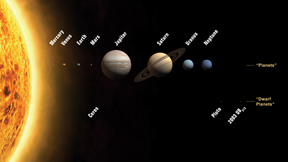|
News Notes
Space
Planets redefined: Pluto gets demoted
 The pecking order of planets in the solar system has just been shuffled. Exercising their power to officially name and categorize all things celestial, members of the International Astronomical Union (IAU) voted Aug. 24 to demote Pluto, and to give the asteroid Ceres a promotion. Arriving at this new system, however, was not without controversy among astronomers, the public and even geologists.
The pecking order of planets in the solar system has just been shuffled. Exercising their power to officially name and categorize all things celestial, members of the International Astronomical Union (IAU) voted Aug. 24 to demote Pluto, and to give the asteroid Ceres a promotion. Arriving at this new system, however, was not without controversy among astronomers, the public and even geologists.
In August, astronomers at the International Astronomical Union meeting in Prague redefined planetary bodies. The new definition stripped Pluto of its planetary status, naming only eight official planets and grouping Pluto with Ceres and Xena into the category of dwarf planets. Image is courtesy of IAU/Martin Kornmesser.
The decision to strip Pluto of its planetary status drops the number of planets from nine to eight: Mercury, Venus, Earth, Mars, Jupiter, Saturn, Uranus and Neptune. The eight bodies meet the newly defined criteria that a planet must orbit the sun, have enough mass to sustain a round shape, and have cleared its orbit of most debris. Pluto, while round-shaped and orbiting the sun, has failed to clear its orbit of the icy disc of debris that comprises the Kuiper belt.
Instead, round bodies like Pluto that orbit the sun, are not moons and do not
clear debris from their paths belong to a new category of “dwarf
planets.” The asteroid Ceres and UB313 — nicknamed Xena by
astronomers — join Pluto with dwarf planet status.
“The eight planets are so distinctly different from everything else
in the solar system,” says Mike Brown, a planetary astronomer at
Caltech in Pasadena, Calif. “Any rational classification has to
acknowledge that difference.”
Previously, most astronomers did not consider Pluto to be a planet, but since its 1930 discovery, “no one has felt the need to go out and put up a big poster that says ‘Pluto is not a planet,’” Brown says. But Brown’s team’s discovery in October 2003 of Xena, which was found to be larger than Pluto and orbiting in the outer solar system, changed that, and “something had to happen,” he says. “Either Xena needed to be declared officially a planet, or they both needed to be declared not planets.”
In August, members of the IAU’s Planet Definition Committee discussed optional definitions during the IAU’s two-week-long annual meeting in Prague. That a planet must be round-shaped is “a simple physical principle which was easily understandable to the public,” says Richard Binzel, a planetary scientist at MIT in Cambridge, Mass., who was on the committee. But the outer solar system holds an “important category where there are many new discoveries being made, and we wanted to distinguish them somehow,” he says.
One initial idea was to group Pluto and the round bodies orbiting beyond Pluto in a new subclass of dwarf planets called plutons. But the name spurred outcry from some members of the geologic community because in geology, the term pluton refers to a rock formed from a magma intrusion.
The Planet Definition Committee was aware “from the moment of conception” that pluton was already a geologic term, Binzel says, but thought that the separate definitions would not cause confusion. “For example, we find mercury on Mercury,” he says. The term pluton, however, along with the successive suggestion “plutonian planets,” failed to earn a majority vote.
The final, official definition includes eight “planets,” three “dwarf planets” and many more “small solar system bodies,” which account for all other objects orbiting the sun that are not moons. While the official wording of the definition “leaves a lot to be desired,” Brown says, the scientific concept is “rock solid.” Still, for this researcher who discovered Xena, a solid definition “doesn’t mean that I’m not sad that Xena’s not a planet,” Brown says. “I’ve been in mourning.”
But at least Xena is not likely to be alone in the outer solar system: Brown thinks that over the next few years, hundreds of objects could be discovered that join the ranks of dwarf planets, and within the next few hundred years that number could grow to thousands.
Kathryn Hansen

 Subscribe
Subscribe

